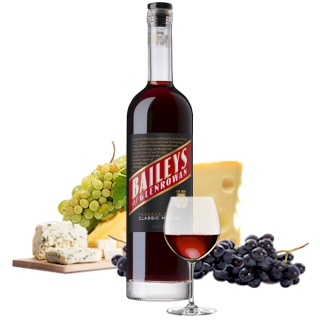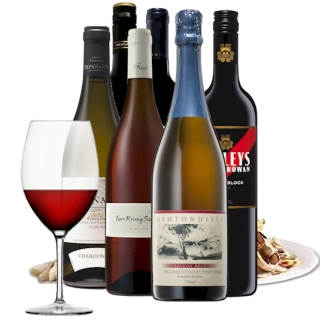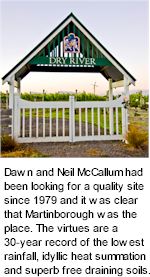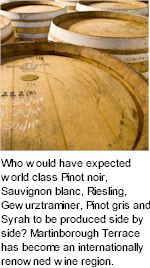


Dawn and Neil McCallum had been looking for a site for a quality vineyard as early as 1979 and it was clear that Martinborough was the place to investigate. According to friend and soil scientist Dr Derek Milne, a founding partner of Martinborough Vineyard, the virtue of this locality was its 30-year record of the lowest rainfall in the North Island and a heat summation appropriate for growing quality cool-climate varieties such as Pinot noir, Riesling and etc. The crescent-shaped area lay along the edge of the river terrace formed by the Ruamahunga and Huangarua rivers about 20,000 years ago. From the available data, the low rainfall area was limited to a tiny locality roughly 5 km in radius, and a study of soil maps revealed that the deep, free-draining gravels they sought within this were restricted to an even smaller part.

By 1986 there were five vineyards and wineries in existence - all planted on the gravels of Martinborough. The pioneers, Ata Rangi, Chifney, Dry River, Martinborough Vineyard and Te Kairanga, decided they would like to define and demarcate the terroir they had adopted, just as such areas are described and mapped in Europe, with the expectation that the wines produced from within this area would show similarities reflecting their origin. A thousand hectares, of which about 600 are available for planting, are comprised almost completely of free-draining gravels with the same very low rainfall and similar aspect, temperatures, wind-run and so on, totally homogenous from a viticultural point of view.
From 1986, wines made from within this area were given a seal of origin by the Martinborough Winemakers Association, and in 1991 the area was named The Martinborough Terrace Appellation to distinguish it from other types of terroir which were being explored nearby. Authentification of the defined area was administered by the Martinborough Terrace Appellation Committee according to a set of rules and regulations descibed as Martinborough Terrace Appellation of Origin System.
The boundaries of the Martinborough Terrace was precisely and legally defined in 1986 and can be summarised as that area receiving an average of less than 800mm annual rainfall over the period 1940-1980. Which also fell within a particular area defined carefully in terms of trig points etc. and contained 80% or more of the technically defined free-draining soils.

It was also allowed that the area could be expanded to include neighbouring areas which yielded fruit similar in quality and style over five successive vintages from 5+ year vines or which corresponded to the rainfall and soil type definitions of the existing Terrace. It is hoped that neighbouring areas will examine their situation and join the Appellation as time goes on.
People affirm there is a particular Martinborough style in wines from this tiny appellation. The few wineries from the Martinborough Terrace who entered their wines in national and international shows have enjoyed a disproportionately high rate of success - particularly with Sauvignon blanc and Pinot noir. By 2002 there were around 25 brands originating from the Terrace, with the numbers continuing to increase. The number and variety of quality wines from this tiny area confounds all expectations. Who would have expected world-class Pinot noir, Sauvignon blanc, Riesling, Gewurztraminer, Pinot gris and Syrah to be produced side by side? Martinborough has become an internationally respected wine area and reference to the Martinborough Terrace terroir by winemakers, locals, winetasters, authors and international commentators persist. Properties within it's boundaries are also greatly sought after. Acknowledgement of this terroir is perceived to have real significance in the understanding of our wine, and for so many it has become a very special place.
Dry River is convinced of the extreme problems posed by climate change including its short and long term impact on the wine industry and regards the need to take action as a practical, business and ethical imperative. CarboNZero is an internationally recognised programme which has been developed in New Zealand for use by both individuals and organisations to measure, manage and mitigate their greenhouse gas emissions. The principal emissions at Dry River involve fuel for both machinery and frost control in the vineyard, electricity and gas use in the winery. To receive certification, vineyards are audited annually and unavoidable emissions are written off against the purchase of carbon credits. In addition it is expected to demonstrate a continuing commitment to improve energy efficiency.
